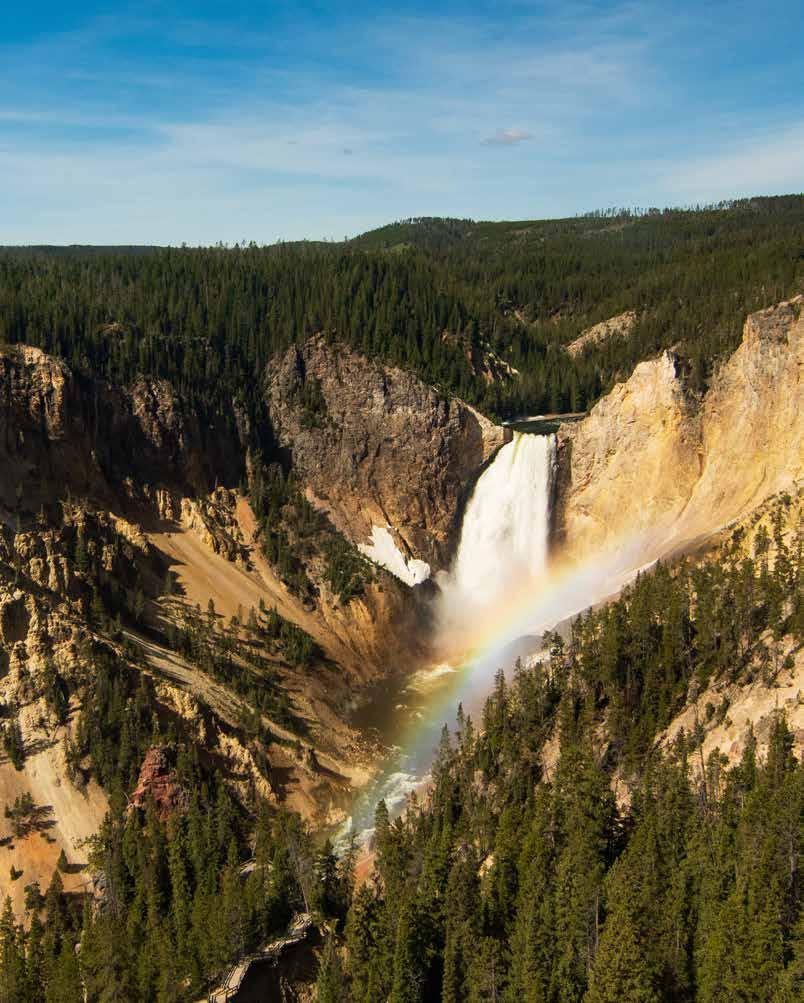

4
6
11
15
18
22
24
26

Editor/Design Courtney




4
6
11
15
18
22
24
26

Editor/Design Courtney

Lake views on the way out or the way back?”
My wife and I were hiking Storm Point Trail in Yellowstone National Park, a 2.3 mile loop that goes past Indian Pond, through the forest, and along Yellowstone Lake. It was after dinner and we wanted to get a little more hiking in. This was also my first time visiting the park and I wanted to take in as much as possible in five days, despite being tired and sore halfway through the trip.
“The way back.”
Like everything else, daylight is precious in Yellowstone.
There had been only one other car in the parking lot at the trailhead. In the meadow by the pond, there were two bison about 30 yards off the trail.
After only two days in the park, I had come to love bison. They just do what they want, seemingly unconcerned with the concerns of tourists like me. They roam and play in the plains, lie down by abundant streams and block the road with no regard for motorists. It’s their home, after all.
 A bison stands by the road near the entrance to Storm Point Trail in Yellowstone National Park.
Photo by Will Briggs
A bison stands by the road near the entrance to Storm Point Trail in Yellowstone National Park.
Photo by Will Briggs
These two bison are content to graze and let us pass unmolested. The day before we got to Yellowstone, a woman had been gored by a bison after she approached it.
We turned right at the fork in the trail to go into the woods. Fittingly, a storm was rolling in. The wind picked up as we walked through the trees. Tree trunks started knocking into one another in the breeze. Other than the rush of the wind, the banging of the trees, the rolling of distant thunder and the beat of our footsteps, there wasn’t a single other sound to be heard on the trail.
One tree fell about 100 yards to our right. I, perhaps not intelligently, had paused to catch whatever was about to happen on video.
There’s nothing quite like being out in nature to make you feel both a sense of awe and utter dependence on its good graces for your well-being. Every time, it shows you caring for nature is tantamount to caring for ourselves. Leave those bison be and you’ll be rewarded with unpunctured skin, unbroken bones and continued life. Don’t leave food out for bears and they won’t attack you and rangers won’t have to put them down. Dump chemicals into the river and fish die, crops fail, wildlife and livestock get poisoned and you and your neighbors end up with some weird disease that might end up in a medical journal someday.
separated the lake from the shore, even in early June. We paused our hike to wander along the lake and go out onto Storm Point and take a bunch of pictures. Taking pictures in Yellowstone feels like cheating – it’s virtually impossible to take a bad photo here, unless your finger gets in the way of your phone camera, which only happened to me once. There wasn’t a single other person around – a deeply personal experience on one of the most popular pieces of public land in the country.
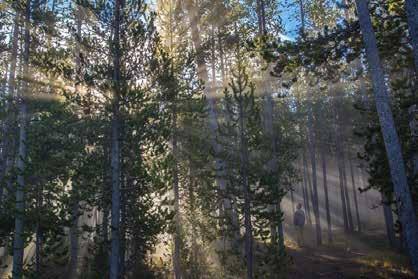
After 30 minutes or so, we resumed our hike, heading into the trees on the other side of the loop. The woods had grown much darker. The trail was muddier. We could see bison tracks all along it, as well as some bear tracks in a few places. The breeze through the trees had died down. Except for our squelching shoes, there was barely another sound to be heard. Over an hour into our hike, we finally came across another person, the only other one we’d see on the trail, who wanted to start with lake views. We greeted each other and kept going.
One of my favorite things about my new home is that recognition of dependence on and need to care for the land is written into life in Montana, both figuratively and literally. The intertwining of humans and nature is even written into the state constitution, a beautiful sentiment not entirely obscured by the legalese of the state code: “the state and each person shall maintain and improve a clean and healthful environment for present and future generations.” Depending on and caring for the land also means depending on and caring for other people, for (hopefully) better or (too often) worse.
That recognition of dependence is also why I, a native Texan who generally loathes the cold, after just a year and a half of living in Montana, have started saying things like, ‘well, we could use the moisture,’ whenever it snows, just like everyone else.
We emerged from the trees and reached the lake. As the storm settled in over the mountains in the distance, the lake was clear blue. A patchwork of ice chunks still
After a half-mile or so, we came back out onto the meadow. It finally started to rain. The pond vibrated from all the rain drops, but the geese didn’t seem to mind. We could see the parking lot. Only one bison remained at the trailhead – its companion had crossed the road to move into a different, undisturbed meadow.
Eight days after we left Yellowstone, a massive flood forced the evacuation of the park, with torrential rains and high temperatures combining to liquidate heavy snowpack, bringing the Yellowstone River to two feet above its previous measured high. Homes were flooded, bridges and roads washed out, and the north loop of the park was closed indefinitely, each rifts in the relationship between land and people, certainly not the first, definitely not the last. Depending on the land will break your heart. There’s no way around it.
The rain shower passed as we got close to the car. We finished our hike about an hour before sunset. The lone remaining bison had moved to a spot about ten feet from the road, still grazing peacefully. A rainbow sat against the storm clouds. As we slowly drove away so as not to disturb the bison, I took a few final pictures.
This place really is precious.

Over 600,000 years ago, Yellowstone experienced an eruption 1,000 times bigger than Mount St. Helens. Last year, Yellowstone experienced flooding like it may not have seen in the last 500 years. For those visiting Yellowstone during and even after the flooding, they got to be a part of history. They experienced an event that we may not see again in our lifetime and that will be talked about for years to come. Yellowstone is a dynamic landscape and is constantly changing, from volcanic eruptions to glaciers to flooding. There is a good chance that what you see today could be different tomorrow.
If we look back 2.1 million years ago, Yellowstone experienced its first major eruption and the largest of the three. Since that time, there have also been eruptions 1.2 million and 640,000 years ago. As you drive around Yellowstone, you can find evidence of these eruptions. What you look at and think of as a hill, canyon or mountain is, in fact, traces of these eruptions. When a volcano erupts, we often think of lava being forced from the volcano. At the same time, gasses, ash and other debris are expelled during these eruptions. There is a good chance that the mountain you are looking at is actually a rock called “tuff” or, if you are not a geologist, ash that has turned into a rock. That canyon may be made up of basalt or rhyolite; both of these rocks are lava that has cooled and hardened over time.
Although Yellowstone is best known for its volcanoes, glaciers, floods and earthquakes have all helped change the landscape. At one time, there was close to 4,000 feet of ice covering Yellowstone during the Pinedale glaciation period nearly 15,000 years ago. In more recent years, a 7.6 magnitude earthquake shook Yellowstone in 1959, causing all kinds of changes.
Often, we think of the major events that have rocked Yellowstone, but on a day-to-day basis, smaller events are always creating change. Yellowstone is still considered an active volcano, but no one is predicting an eruption any time soon, at least not a volcanic one. There are around 500 geysers in Yellowstone, some of which erupt multiple times
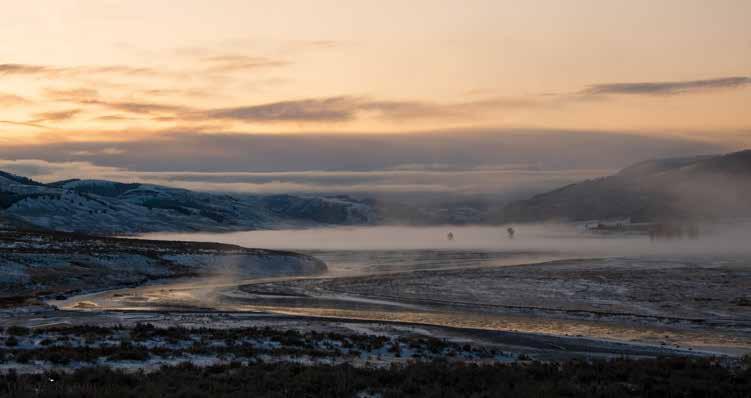
a day. This is due to the source of Yellowstone’s volcano, a giant magma chamber about 5 miles below the surface. This magma chamber could be upwards of 1475F. The heat from this chamber heats the water, creating an underground plumbing system. As the water heats up, it has to find a way to escape, which can be through an existing geyser, a hot spring, or by creating a new hot spring or geyser.
An occurrence like this is not uncommon; a few years ago, this occurred underneath a boardwalk close to Old Faithful. The ground started pulsating, eventually opened up, and was replaced by water and a small geyser. In this case it only lasted a few weeks, and the boardwalk was reopened.
If you visit Yellowstone often, you will notice changes taking place at the sites you frequent. Here are a couple of other recent changes: Dragon’s Mouth at the Mud Volcano started to cave in; Abyss Pool at West Thumb Geyser Basin has changed colors back and forth and is about a foot shallower; Sawmill geyser has gone dormant and become active again over the last couple of years, and Mammoth Hot Springs runoff channels are always changing.
Last year, Yellowstone was flooded, causing damage to roads, buildings and some infrastructure; rivers poured over their banks, trees were swept away and erosion took place. The infrastructure damage has all been addressed and fixed – roads were rerouted and buildings were repaired. If you have never been to Yellowstone, you may not even notice the difference. But if you have, as you drive through the Park on your next visit, you will notice large trees fallen over, logs high on river banks, canyons carved wider and dirt and debris along river beds.
It is easy to take the changes that have happened over time for granted. Yellowstone is a dynamic landscape that
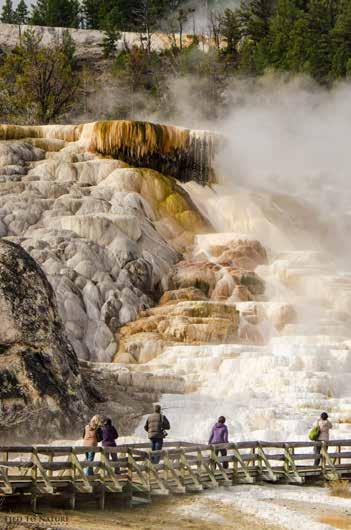
is always changing. As we understand these changes in the landscape, we will have a greater appreciation and understanding of what Yellowstone offers.
All images used in this article © Tied To Nature.

If you’re planning a visit this year to see the wonders of Yellowstone National Park and perhaps hike some of the trails, the experts advise showing up armed with information.
Yellowstone park communication specialist Linda Veress said potential visitors can find a wealth of information on current conditions, road construction and hiking safety on the park’s website (www.nps.gov/yell/planyourvisit).
One of the helpful tips to be aware of is that this year in particular, the park received an extra dose of winter. As of late April and early May, most of the park was still under a heavy blanket of snow. Veress said early spring and summer hikers should take note.
“Prior to hiking in the park, visitors should check the forecast, be very well prepared with proper clothing, shoes and gear for winter hiking conditions,” Veress said in an email. “Hikers should stay alert, carry bear spray and know how to use it.”
Veress said a severe winter brings more winter-killed animal carcasses, which are the first foods sought out by grizzlies after
emerging from hibernations. Bears can sometimes be aggressive protecting carcasses. Male grizzly bears begin emerging in mid March and female grizzlies generally emerge from hibernation the first part of May.
The park has begun offering bear spray rentals at Canyon Village during the hiking season. Certain areas in the park have seasonal closures due to bear activity. For a list of areas, go to the park’s “plan your visit” webpage and check under “bear management areas.”
Yellowstone National Park boasts about 1,000 miles of trails and hiking can be the best way to see the most magical things the park has to offer.
The northeast section of Yellowstone, at generally a lower elevation, features several trails that are often clear of snow earlier than other regions. Trails
around Mammoth Hot Springs and Tower Junction offer good options.
A hike through Mammoth Hot Springs is a great family outing.
Not far from Tower Junction farther east, Hellroaring Trail features a fun suspension bridge over the Yellowstone River and good opportunities to see bison.
Later in the season when snow drifts have melted away, other trails to check out include the trails around the Grand Canyon of the Yellowstone. Expect unforgettable views of the massive falls and backcountry lakes. The Uncle Tom’s Cabin trail is also a worthy historic venture.
For those up for a challenge, hike to the top of Bunsen Peak for
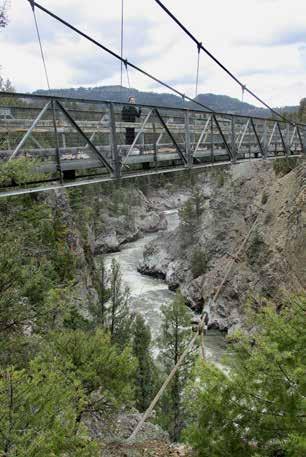
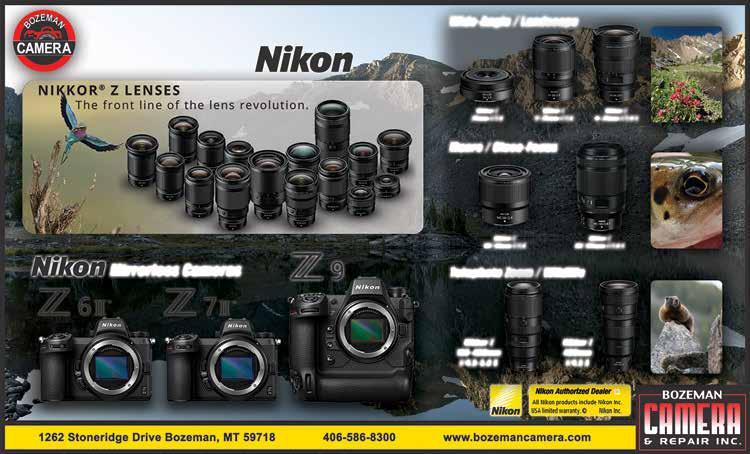







some great views of the park. This summertime, 4.6-mile hike gains 1,300 feet along the way. This trail is located a few miles south of Mammoth Hot Springs, with the trailhead just south of Golden Gate and Rustic Falls. The parking area is unpaved and relatively small, and can often be full during the summer.
If you’re on your way to Old Faithful, stop off at Biscuit Basin first and hike out to Mystic Falls. Along the way you’ll pass colorful hot pools and geysers.
For a more out of the way part of the national park, head east from Ashton, Idaho to the southwest corner of the park and visit Cave Falls. From the falls, you can hike a trail along the Bechler River for a couple of miles, or make a longer day of it by hiking a loop trail to the Bechler Ranger Station and back. Because this is a wetter part of the park, go prepared to battle mosquitoes.
If you wish to campout in the park, all campgrounds except for the Mammoth Campground are reservation only. Park campgrounds usually fill up well in advance (so make reservations ASAP). Reservations are made through two online sites: reservations.gov or Yellowstone National Park Lodging depending on the site.
If sleeping in the backcountry is your thing, you’ll need a backcountry permit. A good place to start is by looking up the park’s “Backcountry situation report” on its website. You can also call the Central Backcountry Office at 307-344-2160 or

the park is checking on the road situation. Some roads in the park don’t open until later in the season because of the weather and snow levels. Other roads and bridges are under construction and will have delays or even temporary closures.



Superintendent Cam Sholly was recently interviewed about Yellowstone National Park’s 150th Birthday celebrations.
In the interview, Superintendent Sholly reminds us that “Yellowstone is the world’s first national park, established in 1872. But it’s more than just a park: it’s an American icon, and a symbol of the American West. And the park’s history is really one of triumph and tragedy, from the displacement of Native American tribes to the park’s role in the conservation movement.”
When asked “What are some of the park’s conservation efforts?” the Superintendent replied “Well, conservation has been part of Yellowstone since its inception. The idea of setting aside this place for the enjoyment of future generations was a really revolutionary idea at the time. Today, we face new challenges like climate change and other issues, but our mission remains the same: to preserve and protect this place for future generations.”
Looking to the future, the video also explores what is next for Yellowstone National Park?

Superintendent Sholly relays, “Well, we’re really focused on continuing to improve the visitor experience while also protecting the park. We want people to come here and have a great time, but we also want to make sure that they leave with a greater appreciation and understanding of the park’s natural and cultural resources.”
And finally, the 150th anniversary celebrations were obviously a big deal. What were some of the key events?
Superintendent Sholly shared, “We had a great year of celebrations, with events and activities throughout the year. Vice President Kamala Harris visited the park, which was a huge honor for us. We also reopened the Old Faithful Visitor Education Center, which was a major milestone. But really, the highlight of the year was just seeing so many people come out to celebrate and enjoy the park.”
To view the interview in it’s entirety, along with other videos about the Park including Wolf Management, Fish Management, the Tribal Heritage Center and more, visit: https://www.nps.gov/yell/getinvolved/virtual-video-series. htm.


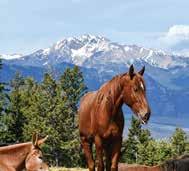
YellowstoneNationalParkLodges.com
All parks have certain challenges,” says Lori Gruber, Yellowstone accessibility coordinator, about access for visitors with mobility issues. “In Yellowstone the weather and number of pedestrians can cause problems in something seemingly as simple as where a boardwalk meets a trail or asphalt.” Still, media entities including Frommers, Roadtrippers. com, Men’s Journal, Outdoorsy.com, AmeriDisability, and Outside have recognized Yellowstone as one of best national parks for those with mobility issues.
The park’s Accessibility Guide to Yellowstone booklet, which is also available on the park website, includes the most detailed accessibility maps and information organized by developed area. Download the free NPS Yellowstone app, which has a park map over which you can apply a “Wheelchair Access” filter to show trailheads and facilities that are wheelchair accessible. Also, the park’s primary front-country boardwalks and trails — Canyon, Fountain Paint Pot, Fort Yellowstone, Mammoth Hot Springs, Mud Volcano, Norris Geyser Basin, Old Faithful, West Thumb, and Old Faithful Historic District — have trail guides that include

a map. These maps note where the site meets federal standards for wheelchair accessibility.
Almost all activities and tours offered by Yellowstone National Park Lodges can accommodate visitors in wheelchairs.
The America the Beautiful – The National Parks and Federal Recreational Lands Pass Series includes the Access Pass, a free, lifetime admission and discount pass for U.S. citizens and permanent residents with permanent disabilities. The pass is available online and at Yellowstone’s entrances and visitor centers with a $10 processing fee. There is no processing fee when purchased in person at a park entrance. Yellowstone National Park allows qualified service animals that assist people with disabilities and defines a service animal as “a dog that performs some of the functions and tasks that the individual with a disability cannot perform such as carrying a pack for persons with mobility impairments, assisting persons with balance, or alerting medically dependent persons of specific conditions such as oncoming seizures.” Dogs meeting this definition must be leashed. Companion dogs and other pets that are used to provide
comfort or emotional support are not allowed in buildings, the backcountry, on nature trails, or on boardwalks.
Here are the accessibility details for the developed areas of the park.
Canyon
Gruber says Canyon is the most accessible area of the park for visitors in wheelchairs. “The Canyon Village Area includes views and waterfalls, and an accessible visitor center, lodging, campground, restaurants, and shopping,” she says. “The Overlooks and Trails Restoration Project has been a multi-year effort to restore the many viewpoints from which people enjoy the Grand Canyon of the Yellowstone, the Upper Falls, and the Lower Falls. Artist Point, Inspiration Point, Lookout Point, Grand View, and Uncle Tom’s Point have been restored with accessible parking, vault toilets, and routes to overlooks.”
The Canyon Visitor Education Center is wheelchair accessible and there are accessible rooms in all the Lodges and five accessible Western Cabins.
Lake
For years, Gruber has recommended that visitors with mobility challenges take the one-hour Scenicruise on
Yellowstone Lake, which leaves from Bridge Bay Marina. “The boat has a place to secure a person in a wheelchair, has great interpretive guides, and is a bargain for the price,” she says. After departing Bridge Bay, the Lake Queen heads out and around Stevenson Island, most notable for the wreck of the 500-passenger ship, the E.C. Waters, which has sat off its shore since 1906. In addition to the shipwreck, you might also see eagles and osprey while on this cruise.
There is a wheelchair-accessible fishing area on the Madison River. Park at the Mount Haynes Overlook. From here, a level boardwalk leads to the river and fishing access. (Whether in a wheelchair or not, anyone over the age of 16 requires a Yellowstone National Park fishing permit to fish in the park; state fishing licenses are not valid here.)
Other accessible sites in this area include viewpoints of National Park Mountain and Firehole Cascade. The Two Ribbons Trail is a wheelchairaccessible boardwalk along the Madison River; the boardwalk loop to Terrace Spring includes a steep grade in the middle of the loop that wheelchair users will likely need assistance to get up.
The Mammoth Hot Springs Hotel and Cabins has two accessible hotel rooms and four accessible cabins. If you don’t stay here, at least check out the hotel’s accessible Map Room, which features a 17-foot 2-inch by 10-foot 4-inch map made of 2,544 pieces of wood from 15 different species of trees. The map shows the U.S. as it was in 1936. In non-Covid times, the room offers a bar menu. If you want more to eat, try the accessible Mammoth Hotel Dining Room, which is the first 4-Star certified restaurant by the Green Restaurant Association in the entire National Park System. The dining room is accessed through the Mammoth Terrace Grill.
Like at Old Faithful, many of the Mammoth boardwalks are accessible, but have some steep sections and transitions from asphalt walkways
to boardwalks that will likely require manual wheelchair users to be assisted. See the Mammoth Hot Springs Trail Guide Map, available at trailheads in the area, for details on these sections. There is an accessible parking space on the left a short distance upon entering Upper Terrace Drive; from here, a boardwalk begins on the right and takes you to views of the hot springs. About .7 of a mile farther along Upper Terrace Drive, there’s another wheelchair-accessible parking spot and a short boardwalk to Orange Spring Mound.
Junction, the half-mile Forces of the Northern Range boardwalk loop is wheelchair accessible. Passing over open meadows, the trail includes interpretive signs, benches, and exhibits that explain the mountains, geology, and landscape in the area.
Norris
Norris is the hottest, most acidic, most changeable, and most varied thermal area in the park. Wheelchair travel into Porcelain and Back Basins is not possible because of stairs, steep sections, and changes in trail surface, among other issues. With assistance, wheelchairs users can reach Emerald Pool and Echinus and Steamboat Geysers, which is well worth the effort. The two geysers are among the most interesting in the park: Echinus is the largest of the known acid-water geysers in the world; Steamboat is the tallest active geyser in the world. Steamboat’s eruptions can be between three days and 50 years apart. From March 2018 to the end of 2020, Steamboat has erupted an unprecedented 128 times. By comparison, between 1985 and 2017, the geyser had only 15 major eruptions. If you’re fortunate enough to catch one, it can shoot water as high as 380 feet into the air.
The Museum of the National Park Ranger, in a 1908 building that was one of the park’s original soldier stations, has a wheelchair-accessible entrance and exhibits on the history of the National Park Service and the ranger profession. The building will be closed for rehabilitation in 2021.
Several miles south of Norris Junction,
the lower portion of the Artists Paintpots Trail is wheelchair accessible. (Note that the upper trail is not.)
Opened in August 2010, the Old Faithful Visitor Education Center is fully ADA-compliant and includes exhibits on almost everything you ever wanted to know about hydrothermal features.
All of the hotels and restaurants in the Old Faithful area are accessible, including the historic Old Faithful Inn, which has hosted guests since 1904 and has a seven-story lobby, the centerpiece of which is an 85-foot-tall stone fireplace. The upper lobby may be accessed via an elevator.
There are wheelchair-accessible boardwalks and walkways to Old Faithful, which is neither the biggest geyser nor the most predictable geyser in the park, but is the biggest predictable one. The next biggest attraction in this area is the Grand Prismatic Spring, the country’s largest hot spring and the world’s third-largest. It’s 121 feet deep, bigger than a football field in diameter, and, because of heatloving microbial mats, a rainbow of colors. The .8-mile boardwalk around it is accessible and has benches.
The highlight of this area is watching wildlife in the Lamar Valley — seeing bison is pretty much a given and if you’re lucky, wolves as well. Numerous viewing areas have wayside exhibits and some have designated accessible parking. The best way to find these is via the NPS Yellowstone app. Go to the map and put on the “Wheelchair Accessible” filter.
The West Thumb Geyser Basin is the largest group of geysers on the shore of Yellowstone Lake, the largest highelevation lake in North America. The boardwalk loops here are accessible with assistance (the lower loop has a section on which the grade is almost 10 percent). Visitors using wheelchairs can get to the Thumb Paint Pots and Twin Geyser without assistance.


At one point during our ride, I stopped to talk to our guide, Jay O’Connor as he was looking at a lump of brown fur about 100 yards away in the meadow adjacent to the road.
Suddenly “the lump” heard us and stood up – a large bison put his tail up and turned towards us with his head bowed slightly. I asked O’Connor, “Is he..?”
He replied, knowing what I was going to ask, “Yes, it looks like it, doesn’t it? But he’s so far away, I don’t think he will charge us. I think he just wants us to know he is there.”
On April 12, I set out on a surreal adventure. Jay O’Connor, guide and owner of Big Sky E-bikes in Gardiner, met clients at 9 a.m. for a full day e-bike excursion through Yellowstone National Park. The full day tour and bike rental fee included a sack lunch and bottle of water. If you get lucky, you might even get to try some Girl Scout Cookies (Thin Mint).
O’Connor is an excellent resource for planning your trip, guided or not, into the park. He had some great advice on what gear to bring and what to expect; this conversation is highly
recommended so that you know what you are getting yourself into. The wilderness in Yellowstone is beautiful, but it can also bring a lot of dangers, and it’s good to be informed before you go.
On this particular trip, there were five people from France, birthday boy Arthur Vitali, 12, and his family –mother, Victoria, father, Guillaume, and two sisters, Emma, 16, and Chloé, 14.
“It was kind of a sporty thing and it took me a lot of effort,” said Carolina Federbuschof Dreseden Germany, who joined the adventure with her 6-yearold, Jonas, in tow. “I was not sure if the guide knew we don’t do this everyday.

But it’s also a nice workout. It was great. You had to be careful, of course, and take your time and not ride ahead of the guide. There were some trucks coming and we had to be careful. It gets adventurous because it’s not that easy. I liked it.”
Young Jonas held on for the entire ride, and was seen smiling from ear to ear throughout the day.
David Ogden, a return client of O’Connor’s from Seattle, who ironically spoke fluent French and was able to translate, met his friend Skip Johnson from Minneapolis for the adventure as well.
The wind howled, the clouds shifted our light from bright and sunny contrasted with toilet and grey. The wind died back down, then increased again, and repeat. We headed up the mountain pass with cliffs all around, cross winds, gravel and sharp turns.
There was no one else around, at least no humans. You realized how big the unknown wilderness was around you once you entered the valley above
Mammoth, on the way to Norris.
It was just us with our guide and the bikes, peddling down the middle of a desolate highway deep in a mountain valley, surrounded by walls of snow, in the middle of YNP.
The calm waters of Swan Lake were finally melting, as a pair of swans glided through the glassy water in the bright April sun that had finally emerged for good.
With no traffic, we continued on our path. We immediately came upon a small herd of bison going the same direction we were, taking full advantage of the road closure by walking in the roadway to avoid the deep snow.
O’Connor told the group we would need to wait and give them space and see if perhaps a car would pass. This section is open to park staff and vendors only.
The animals moved over suddenly. It was like a game of cat and mouse, the bison turned back toward the opposite side of the road and some of the herd followed.
Our group all remained quiet and respectful, and finally, the bison picked a side. We passed one by one, quickly and with care.
Many people might hear the term “e-bikes” and think “great, no peddling.” But that is not the case. Let me tell you just how wrong that assumption is.
There’s nothing like a little 36-mile bike ride to make me realize I hadn’t exercised in a while. I was so grateful for the electric-assist on this bike, and I really wanted to ride fast and charge up ahead of the whole lot.
I was liking the 17-19 MPH I was traveling on the e-bike at times. I am a person who enjoys feeling a workout.

Did I mention I had gotten confused and thought this was a nine-mile ride?
Through a provided earpiece, O’Connor spoke along the way to guests about bike settings, features in the park and other tidbits of info one might need to hear from their guide.
After seeing O’Connor in quick action with his binoculars at any possible movement in the trees and talking to him about bear safety, I would feel safe with him as my guide, as he seems very experienced and knowledgeable in this field.
He said that a bear eating is nothing to stop and take pictures of – they are highly protective of their food. When we went on our ride, the bears were still in hibernation. They have since started to emerge.
It is important to always carry bear spray and never go on these kinds of adventures alone. Know the signs of wildlife and predators and stay aware of your surroundings. Bears and other animals are attracted to perfumes and food or anything scented.
These adventures are always unique, and everyone must do their part to help preserve this wild space by leaving no trace and taking all garbage and leftovers with you. Let’s keep this as a safe and enjoyable space for all.






 by Adam Brubaker
by Adam Brubaker
As a tour guide in Yellowstone, one of the top questions I receive from guests is, “Will we see a bear?” Their hopes are high, but their faith is lacking, and I believe many are surprised when I mention that there are no guarantees, but their chances are good.
Many people have grown up watching Yogi Bear stealing picnic baskets or have heard stories of bears lining up along the road, waiting to be fed. However, those days are long gone for good reasons. Bear sightings are still frequent in Yellowstone, although they may not be lining the road waiting for you. Roadsides are the best places to see or find bears in Yellowstone. There are two major reasons for this.
First, with 250 miles of road in Yellowstone, there is a lot of habitat that is roadside. Typically, male bears get the best habitat (further away from the roads), and the sows, or females, get what’s left over. Not only this, but bear cubs are often safer in these high-traffic areas, which tend to deter other bears.
Second, there are a lot of open areas along the roadways, such as Lamar and Hayden Valleys. If you do not happen to see a bear right off, stopping in a pullout and spending some time with binoculars or a spotting scope could pay off.
Now, I may have just made it sound like if you are heading to Yellowstone, you are going to see a bear. As a guide, I am in the park almost every day, and I have a lot of people sharing sightings with me, which makes it easier to know where bears are hanging out from day to day. As you don’t have the same knowledge that I have as a guide, I am going to provide some pro tips on how you can see a bear in Yellowstone.
Now, this may not work for everyone, but it is a good option. I know I am a guide, so why would I not suggest this? Here is my experience with a guide. I went to Chicago a couple of years ago and was overwhelmed by the size of it. I had one day to experience it, and I learned pretty fast that walking around was not getting me anywhere. Then I thought, “You are a guide, so why don’t you hire one?” That is what I did. I ended up on the river tour, covered a lot more area, and learned a lot more than if I had tried to do it all by myself.
There are a couple of significant benefits to hiring a guide, and the first is what I mentioned earlier. We are out every day and keep track not only of bears, but other wildlife as well. You may start your trip off by looking for a bear in Hayden Valley. Meanwhile, for the last week, a guide has known a bear was eating from a carcass in Lamar Valley.
Guides typically provide the right equipment for viewing wildlife, including binoculars and spotting scopes. Both of these can come in handy even if a bear is only a hundred yards away. What may be the best part of hiring a guide is the knowledge they have. They will teach you about what the animals are doing and why, and they may provide all kinds of other information about the area while you are with them.

There are better times of the year and days to see bears. Bears hibernate, so typically, if you visit anywhere from November through April, your chances of seeing a bear are slim. Bears do start to emerge in March and show up by April, but these are typically boar (male) bears, and as I mentioned earlier, they are a little more hesitant to approach roads. By May, many bears are out of hibernation, although there may be some sow bears with new cubs waiting a little longer before coming out of their dens. By the time June comes around, all the bears are active and ready to fatten









up after spending all winter in their dens. June into July is the best time of year to see bears, as their food source is plentiful and their mating season is underway. Throughout the summer, the best time to get out and search for bears is typically sunrise, as it is cooler than in the afternoons or evenings. This is the same for much of Yellowstone wildlife: the animals want to be out and active in the cooler temperatures. As the sun starts to beat on their fur coats, they are going to find a place to relax and keep cool for the day.
As the days start to warm up at the end of July and through August, it becomes harder to find bears, and you need to be out early. September and October can be good months as bears go into a state known as hyperphagia, where they know it is time to fatten up for hibernation.
In general, grizzly bears like wideopen areas, while black bears prefer forested areas where they can feel safe with a quick getaway up a tree.
Describing what habitat black bears and grizzlies like just described all of Yellowstone. You can find bears throughout Yellowstone, although some areas provide better habitats than others. Lamar Valley and Hayden Valley are the top two hotspots to see grizzly bears. As both of these locations are wide open, you are less likely to see a bear right off the road. This is where a good pair of binoculars, a spotting scope and some patience will pay off. Unless you show up and someone has already found a bear and points you in the right direction, spending time searching is how you will find one. Cover little areas at a time, looking for
things that don’t quite fit in – shadows and movement are two things to start with.
You are more likely to see black bears from the road – they like forested areas and are more prevalent than grizzly bears. The best habitat for black bears in Yellowstone is centered around Roosevelt Junction. Although there are some areas where you can pull out a pair of binoculars and scan, due to the number of trees, it is better to search as you drive the roads. If you drive around in this area during June or July and do not see a bear, it would probably be beneficial to wait a little bit and drive the road again.
As you are looking for bears, there are a couple of important things to remember. First, if you see a bear that is not black, it does not mean it is a
grizzly bear. Black bears can be different colors, including black, blonde, brown, and cinnamon. You will need to look at other characteristics beyond color to determine the type of bear you are seeing. If it has a large hump on its back, a dished face and small ears, there is a good chance it is a grizzly bear. If it has a flat face, large ears and a high rump, there is a good chance it is a black bear.
The most important thing to remember is that bears are wild and dangerous, and by law, you are required to stay 100 yards from any bear in Yellowstone. This rule is in place to protect you and the bears. If you go hiking in Yellowstone, it is advised that you carry bear spray with you and hike in groups of three or more to help prevent any incidents with bears. Just because bears are dangerous does
not mean you can’t enjoy them from your car or at a safe distance.
While you are in Yellowstone looking for a bear, don’t forget to stop and enjoy the other wildlife that you come across. You will more than likely see the American Bison, the largest land animal in North America; the pronghorn, which is the fastest animal in North America; and any number of the other 67 species of mammals or 300 species of birds found in Yellowstone.

Adam Brubaker is a naturalist and photographer in the Greater Yellowstone Ecosystem. He is the Owner-Operator of TIed To Nature, providing private tours of the Yellowstone area. He can be contacted at (208) 351-5932 or online at tiedtonature.com. All images used in this article © Tied To Nature.


It’s easy to see why Yellowstone was our country’s first national park. The wildlife, thermal features, geysers and other stunning features, make it a must see during one’s lifetime. And while it deservedly gets a lot of love, it can also get a little crowded.
That’s why you’ll want to set up your base camp in a place that can offer day trips into Yellowstone, while also providing plenty of things to see and do on the days in between that are equally amazing.
Here are a couple of our favorite places to explore just outside of Yellowstone that will give you all the “in park” feels, without the crowds.
This amazing “little” town, boasts the longest main street in the country, but is most known for it’s beautiful forests, large natural springs, streams, waterfalls and lakes, all of which make for some world class fishing and outdoor recreating in general.
You’ll find a wide variety of accommodations that are just 20 minutes from the entrance to the park They cater to all kinds of travelers and are often much more affordable than
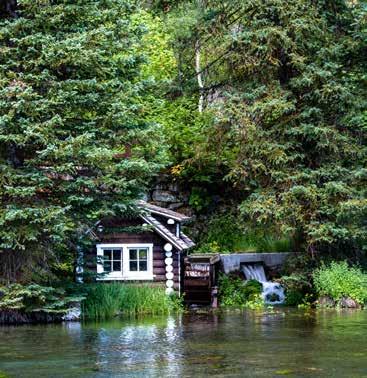
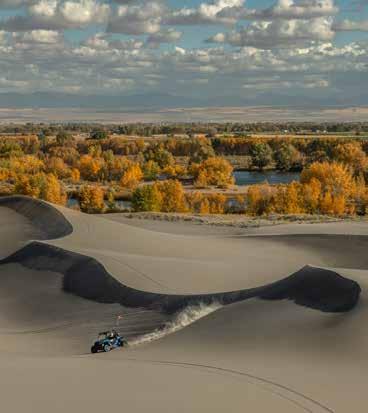
other locations that border the park.
There are also several different outfitters to help guide you through the region no matter your interests – from fishing on the Henry’s Lake to horseback riding in Harriman State Park – you’re sure to find one that can help you experience the area in style. For those that like to DIY, there are also several places to rent your own equipment and explore out on your own.
St. Anthony lies on the west slope of the Continental Divide on the banks of the world famous Henry’s Fork of the Snake River. While it provides world class fishing like Island Park, it’s also home to the largest rideable sand dunes in the country.
With 10,600 acres of white quartz sand blown into 400 foot high dunes, this is the ultimate playground for off-road vehicle enthusiasts. It’s also home to one of the largest herds of wintering elk in the United States.
The dunes have several RV campsites and over 25 acres of dry camping with showers, bathrooms and a fully stocked convenience store, including rentals for razors, atvs, side by sides and several other toys to help you get out on the sand and start having fun!
There are several outfitters and guides in the area for fishing and horseback riding as well.
1. Harriman State Park: The park offers trails for hiking, biking, and horseback riding. In winter, roads and trails

are groomed for cross-country skiing.
2. Upper and Lower Mesa Falls: As tall as a 10-story building, the upper falls pour over remnants of an ancient volcanic super-eruption while the lower falls continue to chisel away at the solidified ash and lava.
3. Big Springs and the Johnny Sack’s Cabin: These springs are the headwaters of the Henry’s Fork of the Snake River, which produces 120 million gallons of water per day and forms wide and crystal-clear pools filled with trout. It is also home to where Johnny Sack built his entire cabin (and most of its contents) by hand back in 1935.
You can find all of these locations, attractions,and other ideas for great “out of the park” ideas at YellowstoneTeton. org.
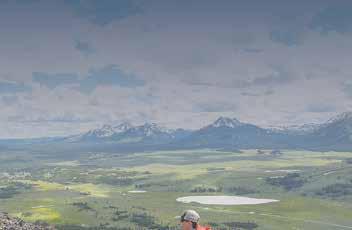



Montana is often known for its sky-scraping mountains and diverse flora and fauna, and while those things are worth the nine-hour drive across the state, be sure to take time to stop in Glendive: a gateway city to the Treasure State just 40 miles from the eastern border.
The small Eastern Montana town just off Interstate 94 boasts numerous locally owned businesses and restaurants, as well as an abundance of recreational opportunities, including hiking in Makoshika State Park, discovering the miles of trails in the Glendive Short Pines OHV area and floating and fishing the Yellowstone River and more.
leisurely enjoyment of what Makoshika State Park has to offer, Burman noted it is a place where people can “still be alone out here.”
“It’s wonderful to experience the peacefulness of Makoshika,” she said.
“We have a natural beauty that people aren’t used to seeing.”
“Glendive is a great stop due to our interstate accessibility and great hotel options, but mainly because of our (Makoshika) State Park, Yellowstone River access and museums,” Glendive Chamber of Commerce Board Member Terra Burman said.
More than that, Makoshika State Park is recorded as Montana’s largest state park to the point former Governor Steve Bullock dubbed it “Glacier Park of Eastern Montana.”
The park has well over 100,000 visitors per year, hitting 150,000 visitors in 2021.
While some may think that’s too many people for the
Makoshika State Park Manager, Riley Bell, noted the park has activities aplenty for visitors, with over 20 miles of hiking trails, bird watching, youth and adult programs, archery and disc golf, to name a few.
“North Dakota and South Dakota both have badland formations, but there is something special and unique about Makoshika that outranks both,” Bell said. “You have to see Makoshika State Park in person to understand how truly wonderful it is … pictures do not do it justice.”
“We have a natural beauty that people aren’t used to seeing,” Burman said. “Our badlands are truly unique, our river is beautiful (and) we have a unique experience because of all of the things you can do and see.”
The Yellowstone River runs through the heart of town. It is viewed year-round from almost anywhere in Glendive, whether it be driving the interstate, crossing the bridge to downtown, walking at various parks or many more locations.


stopping in Glendive, but it is also used frequently by recreationalists throughout the summer months, including for kayaking, tubing, boating or fishing.
In addition to the outdoor opportunities Glendive has to offer, it also features many unique businesses, restaurants, local art and community activities all year long, and not one of them is to be missed.
Just this year, the Justice Foundation raised funds to add lights to Glendive’s historic Bell Street Bridge, lighting up the night with vibrant colors to memorialize individuals, efforts, causes, sporting events and more.
Large murals painted by local artists on the sides of buildings are continually emerging and catch the eye of passersby while driving through town.
Additionally, Glendive is home to Pamela Harr, a worldrenowned bronze sculptor who has made it her mission to fill the town’s streets with her works.
Needless to say, Glendive has a lot to offer, making it the perfect gateway stop on one’s journey to Yellowstone National Park.
“Eastern Montana isn’t what people expect and we love that,” Burman said. “They are expecting us to be flat and we just aren’t … If you stop and stay, you will find a friendly town nestled in the natural beauty of the badlands and Yellowstone River.”


Entrance station
Visitor/Information Center
Campground For a more detailed map and other Park information, visit nps.gov/yell





Even lighter than its original counterpart, LT delivers the same best-in-class carry while providing a thoughtfully simple, capable feature set. From weekend explorations to weeklong expeditions, Atmos & Aura LT is up to task.